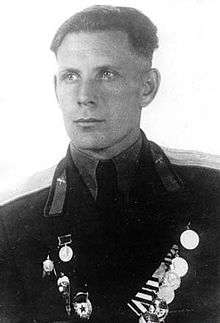Pyotr Dolgov
| Pyotr Dolgov | |
|---|---|
 Pyotr Dolgov | |
| Born | 21 February 1920 |
| Died | 1 November 1962 (aged 42) |
| Allegiance |
|
| Service/branch | Soviet Air Force |
| Years of service | 1940 - 1962 |
| Rank | Colonel |
| Awards |
|
Pyotr Ivanovich Dolgov (Russian: Пётр Долгов; 21 February 1920 – 1 November 1962) (Hero of the Soviet Union)[1] was a colonel in the Soviet Air Force. Dolgov died while carrying out a high-altitude parachute jump from a Volga balloon gondola.[1][2][3][4]
Early life and career
Dolgov was born into a family of farmers in the village of Bogoyavlenskoye (now Dolgovo) in Zemetchinsky District, Penza Oblast. He served with the Soviet airborne in World War II.[1] In January 1945, Dolgov became a company commander in the 350th Guards Rifle Regiment of the 114th Guards Rifle Division. Dolgov participated in the Budapest Offensive and the Vienna Offensive. On 6 April, Dolgov reportedly knocked out a self-propelled gun and killed 40 German soldiers. He was wounded but allegedly refused to leave the battlefield. Dolgov graduated from the Ryazan Higher Airborne Command School in 1947.[1]
He reportedly designed the ejection seats for the Vostok spacecraft.[5]
Death
On 1 November 1962, Dolgov and Eugene Andreyev ascended in a Volga balloon gondola from Volsk, near Saratov,[6] to make high-altitude parachute jumps. Andreyev successfully completed his jump. Dolgov, testing an experimental pressure suit, jumped at 28,640 meters (93,970 ft). The helmet visor of Dolgov's pressure suit hit part of the gondola as he exited, and the suit depressurized, killing him.[1][2][3] On 12 December 1962, Dolgov was posthumously named a Hero of the Soviet Union.[1]
If Dolgov's jump had been successful, he still would not have exceeded the record set by Joseph Kittinger for the highest-altitude parachute jump in history (31,300 meters, 16 August 1960). The current world record is held by Alan Eustace (41,425 meters, 24 October 2014).
Legacy
At the time of Dolgov's death, the Soviet Army newspaper Red Star announced that he had died in the course of "carrying out his duties".[5] Over the years there have been false reports that Dolgov actually died on 11 October 1960, in a failed flight of a Vostok spacecraft.[2][3]
A fictionalized version of Dolgov's death (incorrectly dated in February 1961) appears in the short story "The Chief Designer" by Andy Duncan, which was published in Asimov's Science Fiction magazine and was a Hugo finalist.
References
- 1 2 3 4 5 6 Ufarkinym, Nikolai V. (2000–2011). "Hero of the Soviet Union Pyotr Dolgov: Heroes of the country". Патриотический интернет проект "Герои Страны". Retrieved 6 September 2011.
- 1 2 3 "Dolgov". astronautix.com. Retrieved 6 September 2011.
- 1 2 3 Goebel, Greg. "[15.0] Stepping Up The Pace". vectorsite.net. Retrieved 6 September 2011.
- ↑ Dolgov's year of death is given as both 1961 and 1962 by the Encyclopedia Astronautica, but as 1962 by Goebel and at warheroes.ru. 1962 is correct, as shown by the Der Spiegel obituary cited below.
- 1 2 "DER SPIEGEL 47/1962 - PJOTR IWANOWITSCH DOLGOW". Der Spiegel (in German) (47). 21 November 1962. Retrieved 19 October 2012.
- ↑ "Stratospheric balloons launched worldwide in 1962". StratoCat. 2012. Retrieved 15 October 2012.
External links
- Dolgov at Encyclopedia Astronautica
- Text of "The Chief Designer"
- Interview with Andy Duncan about "The Chief Designer"
- Biography at warheroes.ru